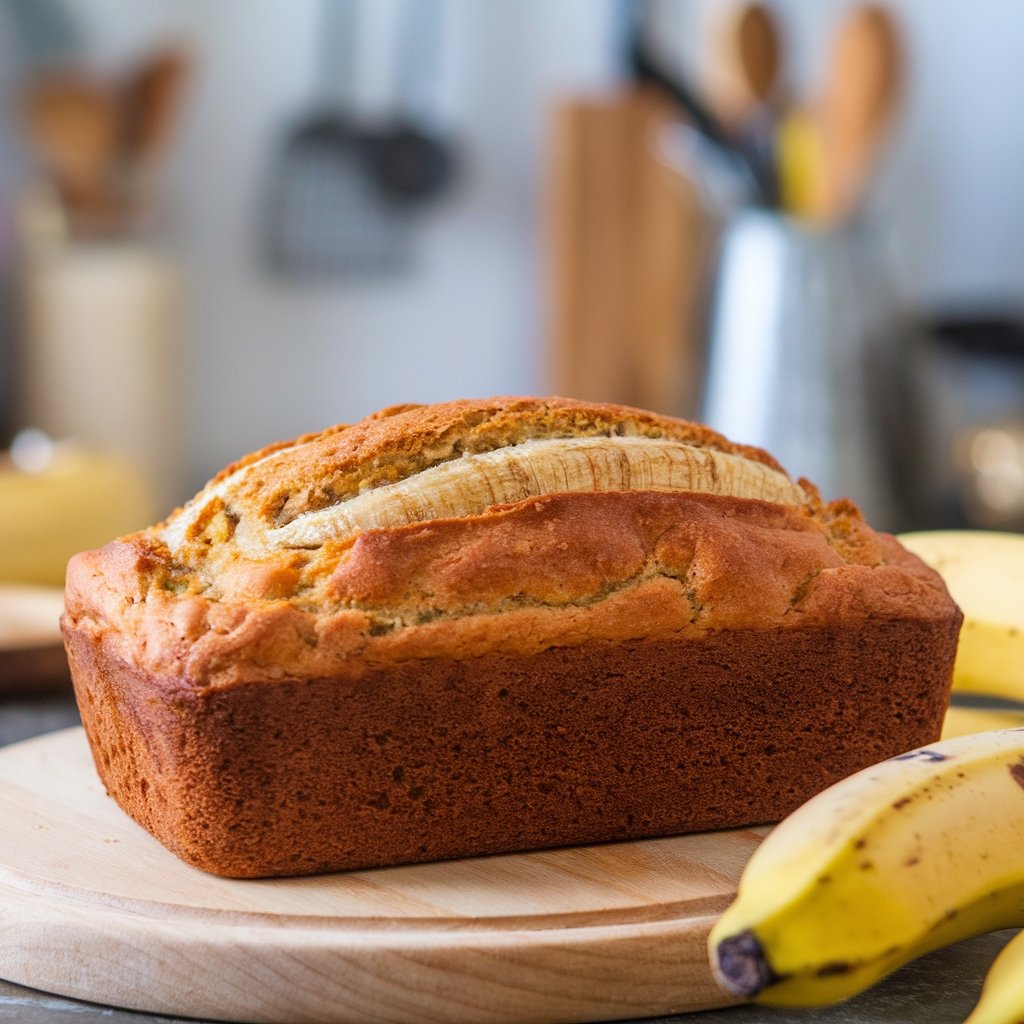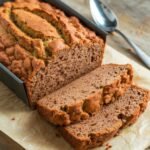Banana bread recipe with oil has secured its place as one of the most beloved baked goods worldwide. Known for its rich texture, moist crumb, and unique flavor, it has evolved beyond a simple snack into a comfort food symbol. The inclusion of oil as an alternative to butter not only enhances its moistness but also adapts the recipe for various dietary preferences. Its story, however, is as fascinating as its flavor.
What Is a Banana bread recipe with oil?
At its core, banana bread with oil is a sweet loaf made by incorporating mashed ripe bananas, flour, sugar, and eggs, with oil serving as the primary fat. Unlike traditional butter-based recipes, the use of oil makes the bread exceptionally tender and allows the flavors of the bananas to shine through. It also offers versatility, accommodating various oils such as vegetable, coconut, or even olive oil.
The Origin of Banana Bread
The concept of banana bread is closely linked to the availability of baking soda and baking powder in the early 20th century. These leavening agents transformed dense loaves into the airy and tender versions we enjoy today.
The Great Depression in the 1930s significantly influenced the popularity of banana bread. During this time, households were encouraged to minimize waste, and overripe bananas became a staple ingredient in inventive recipes. Banana bread provided an affordable, delicious way to repurpose fruit that might otherwise have gone to waste.
If you’re curious about the origins and varieties of breads, check out our comprehensive guide on Kinds of Bread.
How Banana Bread with Oil Differed Historically
The idea of using oil instead of butter gained momentum as dietary preferences and cooking trends evolved. During the mid-20th century, a growing awareness of health benefits associated with certain oils, coupled with their lower cost compared to butter, encouraged this substitution. Additionally, oil-based banana bread is aligned with a rising interest in plant-based diets, further diversifying its appeal.
The Cultural Significance of Banana Bread
Banana bread transcends mere sustenance; it holds cultural and emotional value across various societies. In many homes, the aroma of freshly baked banana bread evokes memories of familial warmth and togetherness. Its simplicity and versatility make it a popular choice for casual gatherings, holiday tables, and comfort food cravings.
Banana bread with oil, in particular, has gained recognition for its adaptability. From adding chocolate chips or nuts to infusing it with spices like cinnamon and nutmeg, the variations are endless. Each iteration carries its cultural nuances, reflecting the preferences of the communities where it is enjoyed.
Why Oil Makes a Difference

Oil contributes to the texture and longevity of banana bread in ways that butter does not. Its liquid consistency keeps the bread moist for longer periods, making it an excellent choice for batch baking or gift-giving. Unlike butter, which requires creaming, oil simplifies the preparation process, reducing the risk of over-mixing.
From a health perspective, certain oils offer advantages such as reduced saturated fat content or added nutrients. Coconut oil, for example, introduces a subtle tropical flavor while providing medium-chain triglycerides (MCTs), which are considered a source of quick energy. Olive oil, on the other hand, imparts a savory note and heart-healthy monounsaturated fats.
Global Variations and Influences
Banana bread recipes are not confined to a single style or culture. In Southeast Asia, pandan banana bread incorporates pandan leaves for a fragrant twist, while Latin American versions may include condensed milk for added sweetness. Caribbean adaptations sometimes feature rum or shredded coconut, reflecting regional ingredients and flavors.
Banana bread with oil has particularly gained traction in vegan and dairy-free baking communities. The absence of butter ensures compatibility with non-dairy diets, opening up this classic treat to an even broader audience.
The Modern Revival of Banana Bread with Oil
The surge in home baking during the COVID-19 pandemic brought banana bread back into the spotlight. Its simplicity and forgiving nature made it a go-to recipe for novice bakers, while its versatility allowed experienced bakers to experiment with creative variations. The oil-based version, praised for its consistent results, was a favorite among enthusiasts seeking reliable outcomes.
Nutritional Insights and Benefits
Banana bread with oil, when made thoughtfully, can offer several nutritional benefits. Bananas are a rich source of potassium, vitamin C, and dietary fiber. Substituting refined sugar with natural sweeteners like honey or maple syrup enhances the bread’s nutritional profile, while whole-grain flours add fiber and nutrients.
Using heart-healthy oils further contributes to its appeal, particularly for individuals monitoring cholesterol levels or seeking plant-based options. The bread’s adaptability to include nuts, seeds, or even protein powders makes it a versatile choice for snackers and health-conscious eaters alike.
Preserving the Moistness of Banana Bread with Oil
One of the defining characteristics of Banana bread recipe with oil is its unparalleled moistness. To maintain this quality, proper storage is essential. Once cooled, the loaf should be wrapped tightly in plastic wrap or stored in an airtight container. Refrigeration can extend its shelf life, although many enthusiasts agree that room-temperature storage enhances its flavor.
Freezing banana bread with oil is another practical option. Individual slices can be wrapped and frozen, making it convenient to enjoy a quick, homemade snack at any time.’
For a modern take on specialty breads, explore the flavors of Grilled Avocado Bread.
The Emotional Connection to Banana bread recipe with oil
Beyond its taste and texture, banana bread with oil holds an emotional resonance for many. The act of baking this bread often becomes a cherished tradition, passed down through generations. Its simplicity fosters creativity, allowing bakers to put their spin on a timeless classic.
Whether enjoyed with a warm cup of coffee or shared among friends and family, banana bread with oil continues to bring joy and comfort to countless households worldwide.

Banana Bread Recipe with Oil
Equipment
- Medium-sized mixing bowls
- Whisk or fork
- Loaf pan (9x5 inch)
- Spatula
- Measuring cups and spoons
- Oven
Ingredients
- 3 medium-sized Ripe bananas (mashed, approximately 1 cup)
- ½ cup Vegetable oil (canola, sunflower, or coconut oil)
- 2 large Eggs (room temperature)
- ¾ cup Granulated sugar (or substitute with brown sugar for extra moisture)
- 1 tsp Vanilla extract
- 1 ½ cups All-purpose flour
- 1 tsp Baking soda
- ½ tsp Salt
- ½ tsp Ground cinnamon (optional, for extra flavor)
- ½ cup Mix-ins (optional, such as chopped walnuts, pecans, or chocolate chips)
Instructions
Step 1: Preheat and Prepare the Pan
- Preheat your oven to 350°F (175°C).
- Grease a 9x5-inch loaf pan with oil or line it with parchment paper for easy removal.
Step 2: Mash the Bananas
- In a medium bowl, mash the ripe bananas using a fork or potato masher until smooth but with a few small lumps for texture.
Step 3: Mix the Wet Ingredients
- In a separate bowl, whisk together the vegetable oil, eggs, sugar, and vanilla extract until smooth and well combined.
- Stir in the mashed bananas.
Step 4: Combine the Dry Ingredients
- In another bowl, mix the all-purpose flour, baking soda, salt, and optional cinnamon.
- Gradually add the dry ingredients to the wet mixture, folding gently with a spatula until just combined. Be careful not to overmix, as this can result in a denser bread.
Step 5: Add Mix-Ins (Optional)
- If using mix-ins, gently fold them into the batter.
Step 6: Transfer and Bake
- Pour the batter into the prepared loaf pan, spreading it evenly.
- Bake in the preheated oven for 50–55 minutes, or until a toothpick inserted in the center comes out clean.
Step 7: Cool and Serve
- Allow the banana bread to cool in the pan for about 10 minutes.
- Transfer it to a wire rack to cool completely before slicing.
Notes
- Oil Options: Vegetable oil ensures moistness, but you can use melted coconut oil or light olive oil for a different flavor profile.
- Ripe Bananas: Overripe bananas with brown spots are best for this recipe as they add natural sweetness and moisture.
- Gluten-Free Option: Substitute all-purpose flour with a 1:1 gluten-free baking mix for a gluten-free version.
- Sugar Alternatives: Swap granulated sugar for coconut sugar or a natural sweetener like maple syrup.
- Storage: Store banana bread in an airtight container at room temperature for up to 3 days or in the refrigerator for up to a week.
Variations:
- Chocolate Banana Bread: Add 2 tablespoons of cocoa powder to the dry ingredients.
- Nutty Banana Bread: Add ½ cup of your favorite chopped nuts.
- Tropical Twist: Stir in shredded coconut and diced dried pineapple for a tropical flair.
